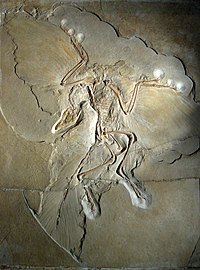
Back تطور الطيور Arabic Evolució dels ocells Catalan Evoluce ptáků Czech Evolución de las aves Spanish فرگشت پرندگان Persian Histoire évolutive des oiseaux French Evolución das aves Galician אבולוציה של עופות HE A madarak evolúciója Hungarian Evoluzione degli uccelli Italian
The evolution of birds began in the Jurassic Period, with the earliest birds derived from a clade of theropod dinosaurs named Paraves.[1] Birds are categorized as a biological class, Aves. For more than a century, the small theropod dinosaur Archaeopteryx lithographica from the Late Jurassic period was considered to have been the earliest bird. Modern phylogenies place birds in the dinosaur clade Theropoda. According to the current consensus, Aves and a sister group, the order Crocodilia, together are the sole living members of an unranked reptile clade, the Archosauria. Four distinct lineages of bird survived the Cretaceous–Paleogene extinction event 66 million years ago, giving rise to ostriches and relatives (Palaeognathae), waterfowl (Anseriformes), ground-living fowl (Galliformes), and "modern birds" (Neoaves).
Phylogenetically, Aves is usually defined as all descendants of the most recent common ancestor of a specific modern bird species (such as the house sparrow, Passer domesticus), and either Archaeopteryx,[2] or some prehistoric species closer to Neornithes (to avoid the problems caused by the unclear relationships of Archaeopteryx to other theropods).[3] If the latter classification is used then the larger group is termed Avialae. Currently, the relationship between dinosaurs, Archaeopteryx, and modern birds is still under debate.
- ^ Wilford, John Noble (28 March 2016). "'Dinosaurs Among Us' Retraces an Evolutionary Path". The New York Times. Retrieved 28 March 2016.
- ^ Padian, K; Chiappe, LM (1997). "Bird Origins". In Currie, PJ; Padian, K (eds.). Encyclopedia of Dinosaurs. San Diego: Academic Press. pp. 41–96. ISBN 978-0-12-226810-6.
- ^ Gauthier, J (1986). "Saurischian Monophyly and the origin of birds". In Padian K (ed.). The Origin of Birds and the Evolution of Flight. Mem. California Acad. Sci 8. pp. 1–55.
© MMXXIII Rich X Search. We shall prevail. All rights reserved. Rich X Search

